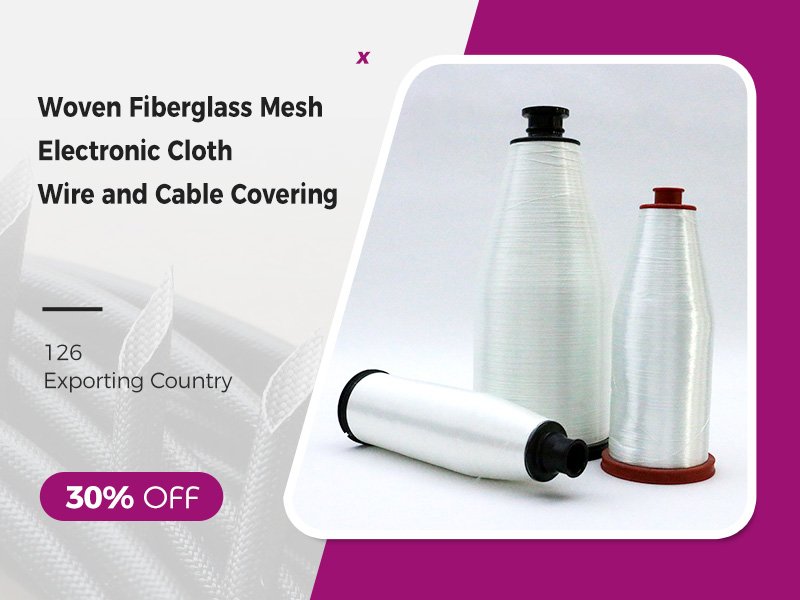- infor1@fiberglassyn.com
- +86-13933702587

Have you ever wondered what makes certain materials stand out in the world of industrial applications? How do some materials offer unparalleled strength while remaining lightweight? And what about thermal insulation—how do certain yarns manage to protect against extreme temperatures? These questions might lead you to explore fiberglass yarn, a remarkable material known for its diverse applications and exceptional properties.
By the end of this exploration, you’ll have a comprehensive understanding of the composition, manufacturing process, and performance characteristics of fiberglass yarn.
Fiberglass yarn, is a versatile material composed of fine filaments of glass. These filaments are woven or twisted together to create a strong, flexible yarn that possesses unique properties, making it suitable for a wide range of applications. The core component of fiberglass yarn is glass, a material known for its robustness, durability, and resistance to various environmental factors.
Glass, in its essence, is made from a mixture of natural raw materials such as sand (silica), soda ash, and limestone. These materials are melted at high temperatures to form a homogenous liquid. The resulting glass is then extruded through fine nozzles to produce long, thin filaments, which are rapidly cooled to maintain their structural integrity. These filaments are the building blocks of fiberglass yarn.
Fiberglass yarn comes in various forms, each designed to meet specific needs. One common type is fiberglass filament yarn, which consists of continuous strands of glass filaments. This type is known for its high tensile strength and is often used in applications requiring durable reinforcement. Another variant is texturized fiberglass yarn, which is treated to create a bulkier, more textured surface. This texture enhances its thermal insulation properties, making it ideal for heat-resistant applications.
One of the notable specifications in the industry is fiberglass yarn 136tex. The “tex” measurement refers to the weight in grams of 1,000 meters of the yarn. A 136tex fiberglass yarn means that 1,000 meters of this yarn weigh 136 grams. This specification is crucial for applications requiring precise weight-to-strength ratios.
In summary, fiberglass yarn is a material made from fine glass filaments, known for its strength, flexibility, and resistance to various environmental factors. It is available in different forms, each tailored to specific applications, and plays a vital role in numerous industrial and commercial sectors.
The manufacturing process for glass fiber yarn is a carefully controlled procedure that transforms raw glass into fine, durable filaments. The process involves several stages, each of which is critical to ensuring the quality and performance of the final product.
The process begins with the preparation of the raw materials. The main ingredients include silica (sand), soda ash, and limestone. These materials are carefully measured and mixed to achieve the desired glass composition. Sometimes, other compounds such as boric acid or aluminum oxide are added to enhance specific properties, such as heat resistance or chemical stability.
Once the raw materials are prepared, they are fed into a furnace and melted at temperatures exceeding 1,400 degrees Celsius (2,552 degrees Fahrenheit). This high temperature environment ensures that the materials are thoroughly melted to form a uniform glass melt.
The molten glass is then extruded through a series of fine nozzles or spinnerets to form filaments. This process is called fiberization and is critical to determining the diameter and uniformity of the glass fibers. The diameter of these filaments can range from a few microns to tens of microns, depending on the intended use.
Immediately after extrusion, the filaments are rapidly cooled to solidify them. This cooling process is usually achieved by blowing air or using a water spray, which helps maintain the structural integrity of the fiber. The cooled filaments are then gathered into bundles, called strands.
These strands are further processed to make fiberglass yarn. The strands are twisted together to form a continuous yarn, a process that imparts additional strength and flexibility. The twist level, or twists per meter (TPM), can be adjusted to produce yarns with different properties. For example, higher TPM values produce yarns with tighter twists and greater tensile strength.
In some cases, the yarns undergo additional treatments to enhance their properties. For example, texturized fiberglass yarn is texturized to increase its volume and insulating capabilities. The process involves passing the yarn through jets of hot air or steam, which causes the fibers to curl and expand.
Quality control is an integral part of the manufacturing process. Various tests are performed to ensure that the yarn meets specific standards for tensile strength, diameter uniformity, and other performance indicators. These tests help guarantee that the final product is suitable for its intended application.
In summary, the manufacturing process of fiberglass yarn involves melting the raw materials, extruding them into filaments, cooling and gathering the filaments into strands, and twisting the strands into yarn. Additional processing and quality control measures ensure that the yarn meets the specifications required for various applications.
Fiberglass yarn is renowned for its excellent thermal insulation properties, making it a highly sought-after material in various industries where heat resistance is crucial. This capability stems from the inherent characteristics of glass combined with the structural advantages of the yarn format.
At its core, fiberglass filament yarn is made from silica, which has a low thermal conductivity. This means that heat does not easily pass through the material, allowing it to act as an effective barrier against high temperatures. When glass is drawn into fine filaments and woven into yarn, these properties are further enhanced.
The structure of expanded yarn fiberglass contributes significantly to its insulating capabilities. The fine glass filaments trap air within the yarn, creating a multitude of tiny air pockets. Air is a poor conductor of heat, and these trapped air pockets act as insulative barriers. This characteristic is especially pronounced in texturized fiberglass yarn, which has a bulkier structure due to the texturizing process. The crimped and expanded fibers in texturized yarn increase the volume of trapped air, thereby boosting its thermal insulation performance.

In practical applications, fiberglass wire yarn is used in environments where high temperatures are a concern. For instance, it is commonly employed in the production of thermal insulation blankets and tapes used in industrial settings.
Furthermore, fiberglass yarn is resistant to moisture and chemical exposure, which can be critical in maintaining its insulating properties in harsh environments. Moisture resistance ensures that the insulating performance is not compromised by humidity or water exposure, while chemical resistance protects against degradation in chemically aggressive settings.
Glass fiber spun yarn is known for its exceptional performance characteristics, which make it a versatile and reliable material in various applications. These characteristics stem from the intrinsic properties of glass fibers combined with the advantages of the spun yarn format.
One of the primary performance characteristics of glass fiber yarn is its high tensile strength. Glass fibers are inherently strong, and when they are spun into yarn, this strength is further enhanced. The process of twisting the fibers together to form yarn increases their overall tensile strength, making the yarn capable of withstanding significant mechanical stress without breaking. This property is crucial in applications where durability and resistance to mechanical wear are essential.
Flexibility is another notable characteristic of fiberglass yarn. Despite its high strength, the yarn remains flexible and can be woven, braided, or knitted into various forms. This flexibility allows it to be used in a wide range of applications, from reinforcing materials to creating complex textile structures. The ability to maintain flexibility without compromising strength is a key advantage in industries such as aerospace, automotive, and construction.
Chemical resistance is another important performance characteristic of fiberglass yarn 136tex. Glass fibers are resistant to a wide range of chemicals, including acids, alkalis, and solvents. This resistance protects the yarn from degradation in chemically aggressive environments, ensuring its longevity and reliability. This property is particularly valuable in industries such as chemical processing, where materials are often exposed to harsh substances.
Chemical resistance is another important performance characteristic of glass fiber yarn. Glass fibers are resistant to a wide range of chemicals, including acids, alkalis, and solvents. This resistance protects the yarn from degradation in chemically aggressive environments, ensuring its longevity and reliability. This property is particularly valuable in industries such as chemical processing, where materials are often exposed to harsh substances.
Moisture resistance is also a significant advantage of fiberglass yarn. Unlike some organic fibers that absorb moisture and degrade over time, glass fibers do not absorb water. This resistance to moisture ensures that the yarn maintains its mechanical and insulating properties even in humid or wet conditions. This makes it suitable for applications in marine environments, where moisture resistance is crucial.
In addition to these characteristics, fiberglass yarn is non-combustible and does not support the spread of fire. This fire-resistant property adds an extra layer of safety in applications where flammability is a concern. The non-combustible nature of glass fibers ensures that fiberglass yarn remains stable and does not contribute to the spread of flames, making it an excellent choice for fire-resistant textiles and insulation.
In summary, the performance characteristics of glass fiber spun yarn include high tensile strength, flexibility, temperature resistance, chemical resistance, moisture resistance, and fire resistance. These properties make it a versatile and reliable material for a wide range of applications, from industrial insulation and reinforcement to protective clothing and textiles. The combination of these characteristics ensures that fiberglass yarn can meet the demanding requirements of various industries, providing durability, reliability, and safety.
Texturized fiberglass yarn is a versatile material used in various applications due to its unique properties. Here are some of its primary uses:
Fire Barriers: It is used in the production of fire barriers and fire curtains, providing protection against fire spread in buildings and industrial settings.
These diverse applications highlight the importance of fiberglass yarn in modern industry and technology. Its combination of high strength, heat resistance, electrical insulation, and versatility makes it an essential material in many fields.
In conclusion, fiberglass yarn is a remarkable material with diverse applications and exceptional properties. From its meticulous manufacturing process to its performance characteristics, glass fiber yarn stands out as a versatile and reliable choice for various industries.
By exploring the composition, manufacturing process, and performance of fiberglass yarn, we gain a deeper appreciation for its role in contemporary applications. Its advantages over other materials, combined with its thermal insulation properties, make it a valuable asset in many fields.

If you have any questions
Please contact us for free consultation and product quotation
Table of Contents Add a header to begin generating the table of contents Big 5 Global – Connecting the Future of Global Construction As a
Table of Contents Add a header to begin generating the table of contents Introduce In the composite materials sector, where strength, versatility and reliability are
You can leave your needs and contact information~and We can provide you with usage suggestions + product suitability analysis + free sample delivery!
Leave us your interest and contact information, and we’ll send you detailed information for your reference!
You can leave the specifications and contact information you need~ Our technicians will immediately organize the exclusive information for you and send it to your email!
You can leave your contact information here, and we will send you detailed specifications and application cases to make your purchase clearer~